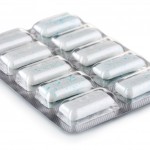
Most patients undergoing fixed orthodontic treatment complain about pain at some stage of their treatment. Studies and reviews reporting pharmacological (Dental Elf – 23rd Sep 2020, Dental Elf – 6th Dec 2016 ) and non-pharmacological approaches (Dental Elf – 11th Jan 2017) have been published. A number of studies have suggested that sugar-free chewing gum is a promising non-pharmacological approach.
The aim of this review was to assess the efficacy of chewing gum in reducing pain intensity in patients undergoing fixed orthodontic treatment.
Methods
A protocol was registered on the PROSPERO database. Searches were conducted in the PubMed, Cochrane Central Register of Controlled Trials (CENTRAL), Scopus, EBSCO, and ScienceDirect databases supplemented by hand searches of the journals European Journal of Orthodontics, Angle Orthodontist, American Journal of Orthodontic and Dentofacial, Orthopedics and the Journal of Orofacial Orthopedics/Fortschritte der Kieferorthopädie from 2010 to 2022. Randomised controlled trials (RCTs) in patients with a minimum age of 12 receiving chewing gum as an intervention to control orthodontic pain in patients undergoing fixed appliance treatment were considered. The main outcome was pain intensity as reported by the patients. Two reviewers independently selected studies extracted data and assessed risk of bias using the Cochrane risk of bias tool. The overall quality of the evidence was assessed using the Grading of Recommendations Assessment, Development and Evaluation (GRADE) approach.
Results
- 16 RCTs involving a total of 2,273 patients were included.
- The trials were published between 2012 and 2022.
- None of the studies were at low risk of bias in all domains with 11 being at high risk of bias in one or more domains.
- 7 RCTs compared chewing gum with pharmacological agents demonstrating a statistically significant difference in the reduction in pain intensity in favour of chewing gum, Standard mean difference (SMD)= -0.50 (-0.90 to -0.10).
- 4 RCTs compared chewing gum with placebo showing a statistically significant difference in the reduction in pain intensity in favour of chewing gum, SMD = -0.58 (-0.92 to -0.23).
- 2 RCTs compared chewing gum with a hard viscoelastic bite wafer finding no significant difference, SMD = -0.15 (-0.56 to 0.26).
- The GRADE certainty of the evidence for all three outcomes was rated as very low.
Conclusions
The authors concluded: –
In patients undergoing fixed orthodontic treatment, chewing gum was significantly more effective than both pharmacologic agents and placebo in reducing orthodontic pain 24 hours after the initial placement of the archwire.
Comments
Working from a pre-published protocol the authors have followed a typical review pathway. A number of major databases were searched supplemented by hand searching of some specific orthodontic journals. Sixteen RCTs were included the majority being published since the 2017 Cochrane review of non-pharmacological approaches to orthodontic pain (Dental Elf – 11th Jan 2017). None of the included studies were at low risk of bias with 11 of the 16 being at high risk and the certainty of the evidence was rated as very low. While overall the findings indicate a benefit for chewing gum use over both placebo and pharmacological agents the analysis was limited to the first 24 hours following appliance activation.
Links
Primary Paper
Mando M, Talaat S, Bourauel C. The efficacy of chewing gum in the reduction of orthodontic pain at its peak intensity: a systematic review and meta-analysis. Angle Orthod. 2023 Apr 12. doi: 10.2319/110622-760.1. Epub ahead of print. PMID: 37043773.
Other references
Dental Elf – 23rd Sep 2020
Dental Elf – 11th Jan 2017
Pain during orthodontic treatment: non-pharmacological interventions
Dental Elf – 6th Dec 2016
Pain during orthodontic treatment –pharmacological treatments
